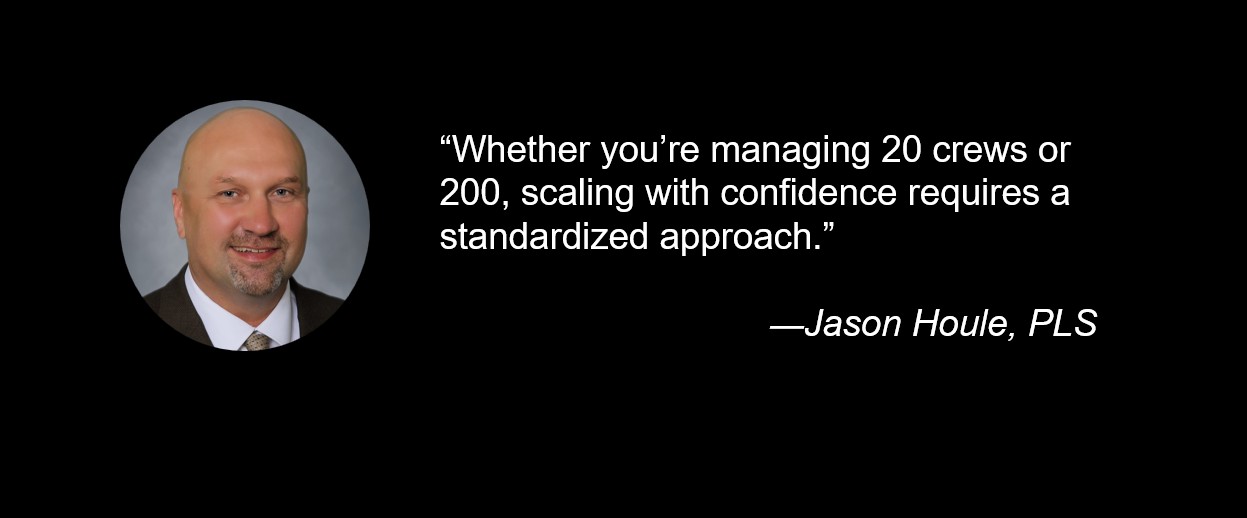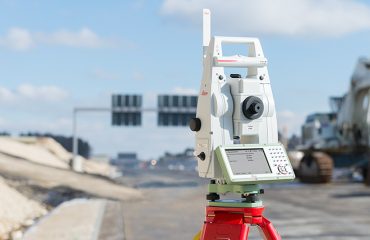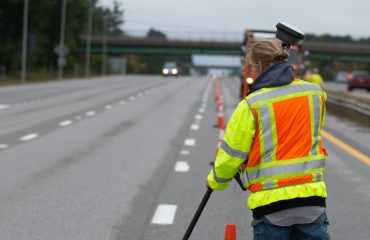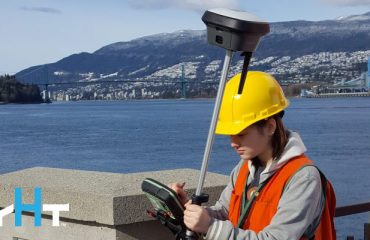Managing multiple offices and crews can cause operational headaches and lost revenue. Jason Houle, PLS, explains the key to eliminating inefficiencies and scaling with confidence.
As a surveying firm grows by adding crews, expanding into new regions, and taking on larger, more complex projects, the challenge of maintaining consistency across operations becomes increasingly critical. This can only be achieved by standardizing processes and workflows.

What’s at Stake When Survey Crews Don’t Follow Standardized Processes?
One of the most common pain points I hear from large civil and survey organizations is this:
“Our teams are collecting data in different formats, and trying to share resources causes all kinds of delays and lost efficiency.”
This lack of standardization in field data collection creates ripple effects throughout the organization, and it becomes difficult to integrate field data seamlessly with company CAD standards. The result is more time spent reformatting, reconciling, and troubleshooting by surveyors, CAD specialists, and engineers who rely on clean, consistent data to produce accurate deliverables.
Without standardized field-to-office workflows, firms face:
- Misalignment between field data and CAD templates
- Increased risk of errors during drafting and design interpretation
- Reduced ability to automate processes or leverage advanced software tools
These inefficiencies are compounded when crews collaborate across offices or rotate between projects, leading to lost productivity and inconsistent deliverables.
Standardized workflows become even more critical when performing construction staking, one of the most liability-sensitive activities in surveying. Any deviation from standardized procedures can cause lost efficiency and lead to layout errors, misinterpretation of plan data, or delays in construction.
These mistakes not only expose the firm to legal liability and insurance claims but also damage its reputation and client trust. A single staking error can cost thousands in rework, and repeated inconsistencies can jeopardize future contracts.
The Hidden Costs of Non-Standardized Workflows
Inconsistent workflows can lead to:
- Data integrity problems: Misaligned formats, missing metadata, or incompatible coordinate systems.
- Project delays: Time lost reconciling field data with office expectations.
- Training inefficiencies: New hires learning different methods depending on which crew they join.
- Client dissatisfaction: Deliverables that vary in quality or structure from one project to the next.
A Real-World Scenario
Imagine a firm with offices in Orlando and Miami, each operating slightly differently. When a crew from Orlando is temporarily assigned to support a Miami project, they may spend 2–4 hours just trying to understand and adapt to the other office’s workflow: how data is collected, formatted, and transferred.
Now, scale that across a scenario with multiple office locations and 20 crews, where inter-office collaboration happens regularly.
Field crew inefficiency:
- 2–4 hours/month per crew = 40–80 hours/month of non-billable time.
- At an average billable rate of \$150/hour, that’s \$6,000–\$12,000/month in lost productivity.
- Annually: $72,000–$144,000 in unrealized revenue.
CAD/Engineering team inefficiency:
- A team of 5 CAD/Engineering staff may spend 3–4 hours/month reconciling inconsistent data formats, correcting errors, and reprocessing deliverables.
- That’s 15–20 hours/month of lost productivity.
- At an average internal cost of $100/hour, that’s $1,500–$2,000/month.
- Annually: $18,000–$24,000 in overhead costs.
Impact on project delivery times:
- These inefficiencies often delay project timelines by 1–2 days per project, especially when data must be reprocessed or clarified.
- For firms managing 50+ projects annually, that’s 50–100 days of delay, which can affect client satisfaction, strain internal resources, and reduce capacity for new work.
- If each delayed day represents $1,000–$2,000 in opportunity cost or penalties, the annual impact could exceed $50,000–$200,000.
Liability in construction staking:
- Construction staking is one of the most liability-sensitive activities in surveying. Any deviation from standardized procedures can result in layout errors, misinterpretation of design intent, or delays in construction.
- These mistakes not only expose the firm to legal liability and insurance claims but also damage its reputation and client trust.
- A single staking error can cost thousands in rework, and repeated inconsistencies can jeopardize future contracts.
Combined Annual Impact
When “an hour lost here and there” gets extrapolated across an entire organization for a year, the numbers are striking.
Between field inefficiencies, office overhead, project delays, and liability exposure, this firm could be losing $140,000–$368,000 per year.
The example is hypothetical, but the thousands of dollars in lost revenue is all too real for many firms.
A Smarter Way to Scale
Whether you’re managing 20 crews or 200, scaling with confidence requires a standardized approach. As the primary consultant in Leica’s Survey Key Account Management program, I’ve collaborated with leading survey firms across the country to address these challenges. The solution involves creating a structure that aligns workflows, improves crew utilization, and protects profitability; all through standardization.
This includes not only field-to-office processes and CAD integration, but also the standardization of hardware platforms across teams. When crews operate with consistent instruments and controllers, it simplifies training, improves data compatibility, and enhances support; all without compromising flexibility or growth.
You don’t have to figure it all out on your own. If your organization is growing, managing complex operations, or simply looking to streamline how survey data moves from field to office, let’s talk.
About the Author
 Jason Houle, PLS, is manager of the Survey KAM program at Leica Geosystems, part of Hexagon, where he leads strategic initiatives to drive growth and operational efficiency for key clients. With over 25 years of experience in the surveying and geomatics industry, Jason began his career at R.H. Batterman & Co., advancing from survey technician to crew chief, project manager, and ultimately firm partner during his 17-year tenure. His experience spans both public and private sectors, including leadership roles at AECOM and Rock County, Wisconsin. A licensed professional land surveyor, Jason combines deep technical expertise with a customer-focused approach to deliver measurable results across the infrastructure and engineering landscape. Follow Jason on LinkedIn >
Jason Houle, PLS, is manager of the Survey KAM program at Leica Geosystems, part of Hexagon, where he leads strategic initiatives to drive growth and operational efficiency for key clients. With over 25 years of experience in the surveying and geomatics industry, Jason began his career at R.H. Batterman & Co., advancing from survey technician to crew chief, project manager, and ultimately firm partner during his 17-year tenure. His experience spans both public and private sectors, including leadership roles at AECOM and Rock County, Wisconsin. A licensed professional land surveyor, Jason combines deep technical expertise with a customer-focused approach to deliver measurable results across the infrastructure and engineering landscape. Follow Jason on LinkedIn >
Note: This article was also published on LinkedIn. See the original article here >





